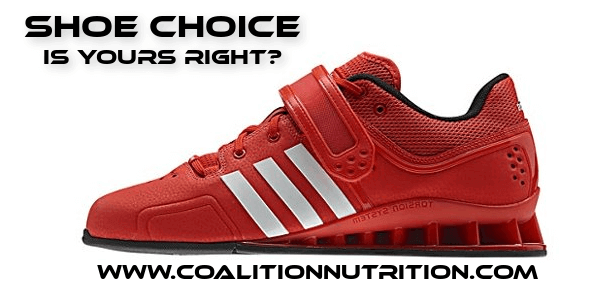Every single detail matters for any serious lifter. Whether that means the timing of the nutrients they take pre and post workout, stretching the night before a hard session, or even the attire that they wear for any given day. Well, it turns out that footwear is something that may be more important than you thought when picking out your outfit. Let’s take a look at the footwear that would be most optimal for you. We will do this by looking at the various types of shoes in section one, and then in section two we will look at the shoe that goes with each lifter and why.
Every shoe has it’s purpose:
Running shoes: The purpose of a running shoe it to propel a runner forward. This is why the toe of every running shoe is curved gently upward. This allows the runner to transfer energy from the back/middle of the foot to the toe more efficiently, creating a “more forward” movement pattern.
Flat soles, Chuck Taylors, Wrestling, Vans: All of these shoes have an extremely flat sole and no angular toe. For chucks this was just for design originally, and didn’t serve much of a purpose. However, for lifters that will be performing many squats, and deadlifts, these shoes are great. They allow the lifter to keep their entire foot on the floor and displace weight through their entire foot or heel more easily, stabilizing them throughout difficult compound movements.
Weightlifting shoes: These shoes have a higher heel (often ¾ in) and taper down to a flat toe. This heel changes the angle of the ankle throughout squats, cleans, and snatches. This angle change actually allows a lifter to keep a more upright torso or push their hips back. This can make depth more achievable or keep ankles and knees safer in some instances. Some studies claim that these shoes CAN put greater emphasis on certain muscles of the thigh, but evidence is inconclusive.
Bodybuilders: Flat Soles
Bodybuilders are generally going to be doing a high amount of volume with a moderate amount of weight for their workouts. For leg days this often means lots of squats, hack squats and leg presses. Muscle activation is everything for these athletes, and barring injury to the achilles or calves, flats such as chuck taylors or a wrestling shoe will be great! Heeled olympic lifting shoes are allowable, but by no means necessary. These flat shoes allow bodybuilders to sit back onto their heels, and unlike running shoes the athlete won’t be tipped toward their toes. For upper body days it really doesn’t matter what they wear. A heeled shoe, flat or running shoe won’t greatly affect an overhead press, bicep curl, or cable tricep extension. IF you are lifting legs, avoid running shoes as they will compromise the integrity of your compound movements.
Powerlifters: Two way tie, Weightlifting, Flat soles
For powerlifters this discussion is very movement specific. Though not necessary, it could be beneficial for powerlifters to have two pair of training shoes. A pair of flats and a pair of weightlifting shoes. Powerlifters often are tight, and fairly immobile in their movements, therefore for squat and any variant of the squat a pair of heels could be advantageous. For deadlift and it’s variants, a pair of flat soled shoes is necessary. The reason that footwear becomes more important for these athletes is that they are exposing themselves to higher loads or relative intensity in their lifts. This makes optimal equipment much more important.
Weight Lifters: Weight lifting
Weightlifters are the no brainer to this article. The clean and jerk and snatch require so much range of motion at the ankle and knee that it is imperative that the athlete be wearing a pair of olympic lifting shoes. This helps the athlete create less tilt or a “more upright torso” and puts them in a better position to perform these highly technical, explosive, and often temperamental lifts. Because of the difficulty of the motions, the high relative intensity and the high range of motion required for this lifts, weight lifting shoes will be the most optimal choice by a wide margin.
CrossFit: Everything
This is a simple statement. There is no cookie cutter option for cross-fitters for footwear. Any given day you could have a long run (running or cross training shoes), a max out snatch (weightlifting shoes), or a max five rep deadlift (converse or flat soles). Unfortunately you may have to drop a few more dollars on your footwear to accommodate the high diversity in your training days.
There is a basic outline of what shoes you should be wearing to optimize performance. Don’t forget, your footwear won’t take you from being a newbie to expert, but it could be that last 1% in performance that you’re looking for.
